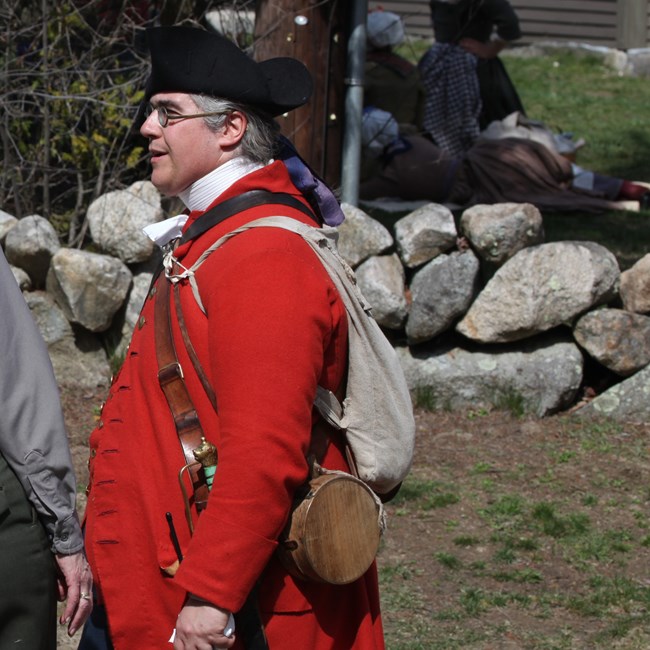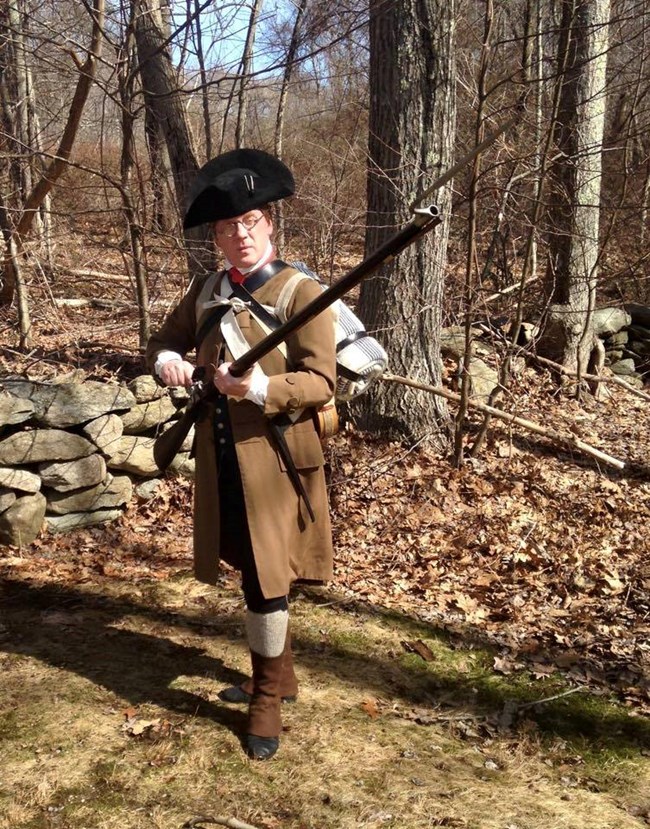|
Visit our keyboard shortcuts docs for details
This video uses new reenactment footage to tell the story of the minute men; how were they organized, trained and equipped, and their role on the day of the first battle of the American Revolution, April 19, 1775. 
The militia was a part time army in colonial Massachusetts responsible for the colony’s defense. Every town was expected to maintain at least one company (approx. 60 men) commanded by a captain. Beginning in 1636 regiments were formed by region and county comprising of several companies within their designated geographic area. In times of war, the militia served as the immediate defense during an attack, or as a pool of available soldiers to be drafted for extended service. According to the law, nearly all men between the ages of 16 and 60 were required to serve, keep arms and train. Exceptions were made for political leaders, judges, and "President, Fellows, Students, and Servants of Harvard College...Ministers, Elders and Deacons of Churches, Sheriffs, Allowed Physicians, or Chyrurgeons (surgeons), and Professed Schoolmasters, all such as have had Commissions, and served as Field Officers, or Captains, Lieutenants, or Ensigns, Coroners, Treasures, Attorney General, Deputy Sheriffs, Clerks of Courts, Constables, constant Ferrymen, and One Miller to each Gristmill, Officers employed in and about Their Majesties Revenues, all Masters of Vessels of Thirty Tuns and upwards, and constant Herdsmen, Lame Persons, or otherwise disabled in Body (producing Certificate thereof from Two able Chyrurgeons) Indians and Negroes.” Most men exempted from training, including “Indians and Negroes” were still required to keep arms (or be provided by the master of the household) and were expected to have them inspected twice per year and to turn out in an emergency. Company-level training was required by law 6 days each year: two days in April, one day each in May and June, and two days in October. Regimental training days, called a “muster” were only held once every few years. Those who failed to appear when required were fined. If they could not pay then they may be subject to physical punishment like being tied up “neck and heels” or “riding the wooden horse, not exceeding one-hour's time...” Repeat offenders could be arrested and thrown in jail. Starting in the fall of 1774, the Massachusetts legislature, meeting in defiance of the Royal Governor, General Thomas Gage, assumed control of the province’s militia forces. On October 26, 1774 they recommended that towns recruit volunteers and “form them into Companies of fifty Privates at the least, who shall equip and hold themselves in Readiness to march at the shortest Notice...” Because they were expected to be ready quickly, “at a minute’s warning...” they became known as “minute men.” Serving in your town’s militia company was required by law. Minute man companies were raised by volunteer. Whereas militia companies trained 6 days each year, minute man companies trained two days each week. Minute men were also paid for training days, on average 1 shilling for each half day. Again, training with the militia was a requirement of law. Minute men also sometimes received arms and equipment from the town. Thus they tended to be better equipped than the militia. For example, many towns purchased cartridge pouches for their minute man companies, and sometimes bayonets. Yes. According to the militia laws, “Indians and Negroes” were exempted (prohibited) from training. However, they were required to be armed and to turn out in an alarm (emergency). During wartime, whenever enlistments lagged, it was not uncommon for Black men to be enlisted for active duty. Sometimes this was done as a substitute for their enslaver who wished to avoid serving himself. This practice continued into the American Revolution as both enslaved and free Black men served. Most often, military service was given in exchange for their freedom, though there were no hard and fast rules about that. On April 19, 1775 about 20 Black men, both enslaved and free, answered the alarm and fought. Some men, like Peter Salem of Framingham, were enlisted as volunteer minute men. 
Captain David Brown's Company Militiamen were required to be armed “as according to law.” This meant that they were to have “a well fixt Firelock Musket, of Musket (69-75 caliber) or Bastard Musket (50-60 caliber) Bore, the Barrel not less than Three Foot and a half long; or other good Fire Arms, to the Satisfaction of the commission officer of the company...” They were also expected to have twenty bullets fit to their gun, one pound of powder, twelve flints, and a cutting sword. Later, bayonets were required for at least half the men in each company. As with the training, fines were levied against those who failed to provide themselves with these arms. Ammunition was often carried in a cartridge box, a leather bag fitted with a wooden block with holes drilled in to accept a paper cartridge, a sealed tube of paper containing a measured amount of powder (enough for one shot) and a lead ball. Militiamen and minute men also had knapsacks, blankets and wooden canteens. Arms were imported into the colony throughout its history from a variety of sources. Sometimes they were purchased by the town or province from British or Dutch merchants or manufacturers. Other times they were provided to the province by the British government during wartime. Merchants regularly imported firearms and edged weapons and advertised them for sale in the newspapers. Arms were also often captured from the French or Spanish by provincial soldiers and brought home. There were also a few gunsmiths in the colony but most weapons were imported. Though there were a few exceptions, like Boston’s Independent Company of Cadets, most militia and minute man companies were not uniformed. The men wore their own clothes. However, that does not mean they were dressed in rags. During training days, like any time spent in public, participants dressed respectably. On April 19, 1775, when the Acton minute company commanded by Captain Isaac Davis was preparing to march for Concord, some of the men were “flouring” their hair! Anderson, F. (1984). A People's Army: Massachusetts Soldiers & Society In the Seven Years' War. Chapel Hill, NC: University of North Carolina. Cain, Alex, “A Bayonet Fitted to His Gun – Why Massachusetts Militia Companies Lacked Bayonets on the Eve of the American Revolution,” Historical Nerdery, December 3, 2016 Historical Nerdery: "A Bayonet Fitted to His Gun" - Why Massachusetts Militia Companies Lacked Bayonets on the Eve of the Revolution (historicalnerdery01.blogspot.com) Cain, Alex, “I Made Me a Cartridge-box: A Quick Primer on Muskets and Cartridge Boxes on the Eve of April 19, 1775” Historical Nerdery, October 24, 2020 Historical Nerdery: "I Made Me a Cartridge-box": A Quick Primer on Muskets and Cartridge Boxes on the Eve of April 19, 1775 (historicalnerdery01.blogspot.com) Fischer, David Hackett. Paul Revere's Ride. United States, Oxford University Press, USA, 1994. Gross, R. (1976). The Minute Men and Their World. New York: Hill and Wang. Hambrick-Stowe, Charles E. and Smerlas, Donna D. (1976). Massachusetts Militia Companies and Officers in the Lexington Alarm. Boston MA: The New England Historic Genealogical Society. Hannigan, John D. “How many men of color served on April 19, and from which towns? Were they slaves or free men?” Scholar in the Park, Summer 2014, Friends of Minute Man National Park, Massachusetts Provincial Congress. (1838). The Journals of Each Provincial Congress of Massachusetts in 1774 and 1775: And of the Committee of Safety, with an Appendix, Containing the Proceedings of the County Convenitons - narratives of the Events of the Nineteenth of April 1775. Boston MA: Dutton and Wentworth, Printers to the State. Welch, J. (2013). Laws, Orders, and Resolutions Concerning the Militia of Massachusetts Bay 1693 - 1775. Wiggin, R. C. (2013). Embattled Farmers: Campaigns and Profiles of Revolutionary Soldiers from Lincoln Massachusetts, 1775-1783. Lincoln MA: Lincoln Historical Society. Zelner, Kyle F.. A Rabble in Arms: Massachusetts Towns and Militiamen During King Philip’s War. United States, NYU Press, 2009. |
Last updated: November 6, 2021
